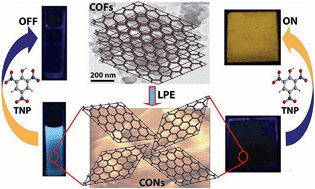The exploitation of porous frameworks, both metal-organic and wholly organic in nature, for their ability to take up and store gases and small molecules, has been well reported over the past few decades. The modularity of these frameworks with respect to their size, flexibility and chemical functionality gives rise to their propensity to adsorb a myriad of chemicals; however, this process is not always selective and the chemical instability of these frameworks can cause difficulties in their extension towards real-life applications. A framework that a) is able to favourably and preferentially adsorb chemicals with high sensitivity, and b) exhibits chemical stability under a wide range of conditions, remains somewhat elusive and is thus a hot topic of investigation in many research groups.
Whilst the uptake and sensing properties of two-dimensional porous polymers have been well studied, the bulk nature of these materials often results in the decrease of their properties on account of the extensive aggregation of the polymer layers and resulting reduction of electrons available to interact with guest molecules. Rahul Banerjee and researchers from the Council of Scientific and Industrial Research – National Chemical Laboratory set out to address this limitation in the field of porous polymers through the Liquid Phase Exfoliation of an imide-based covalent organic framework to its covalent organic nanosheet (CON) analogue. Such a CON, which contains between five and fifteen layers of the material, has chemical and thermal stability equal to that of its bulk counterpart; however, its sensing ability down to 10–5 M towards 2,4,6-trinitrophenol (TNP) and other nitroaromatic explosive chemicals is far superior. Furthermore, this reversible detection upon uptake can be seen both spectroscopically in solution and visually in the solid state via the turning off and on of the CON luminescence respectively.
The ability to quickly and selectively detect chemicals is of paramount interest to researchers worldwide, particularly those chemicals that pose a threat to societal health and safety. The methodology involving covalent organic nanosheets developed in this research offers a new approach to and a first step towards increasing the selectivity and sensitivity of detection by porous frameworks for chemicals, in this case nitroaromatics like TNT.
Read this HOT ChemSci article in full – it’s open access and free to download:
Chemical sensing in two dimensional porous covalent organic nanosheets
Gobinda Das, Bishnu P. Biswal, Sharath Kandambeth, V. Venkatesh, Gagandeep Kaur, Matthew Addicoat, Thomas Heine, Sandeep Verma and Rahul Banerjee
Chem. Sci., 2015, 6, 3931–3939.
DOI: 10.1039/C5SC00512D, Edge Article
About the Writer
Anthea Blackburn is a guest web writer for Chemical Science. Anthea is a recent graduate student hailing from New Zealand, who studied at Northwestern University in the US under the tutelage of Prof. Fraser Stoddart (a Scot), where she exploited supramolecular chemistry to develop multidimensional systems and study the emergent properties that arise in these superstructures. When time and money allow, she is ambitiously attempting to visit all 50 US states.












